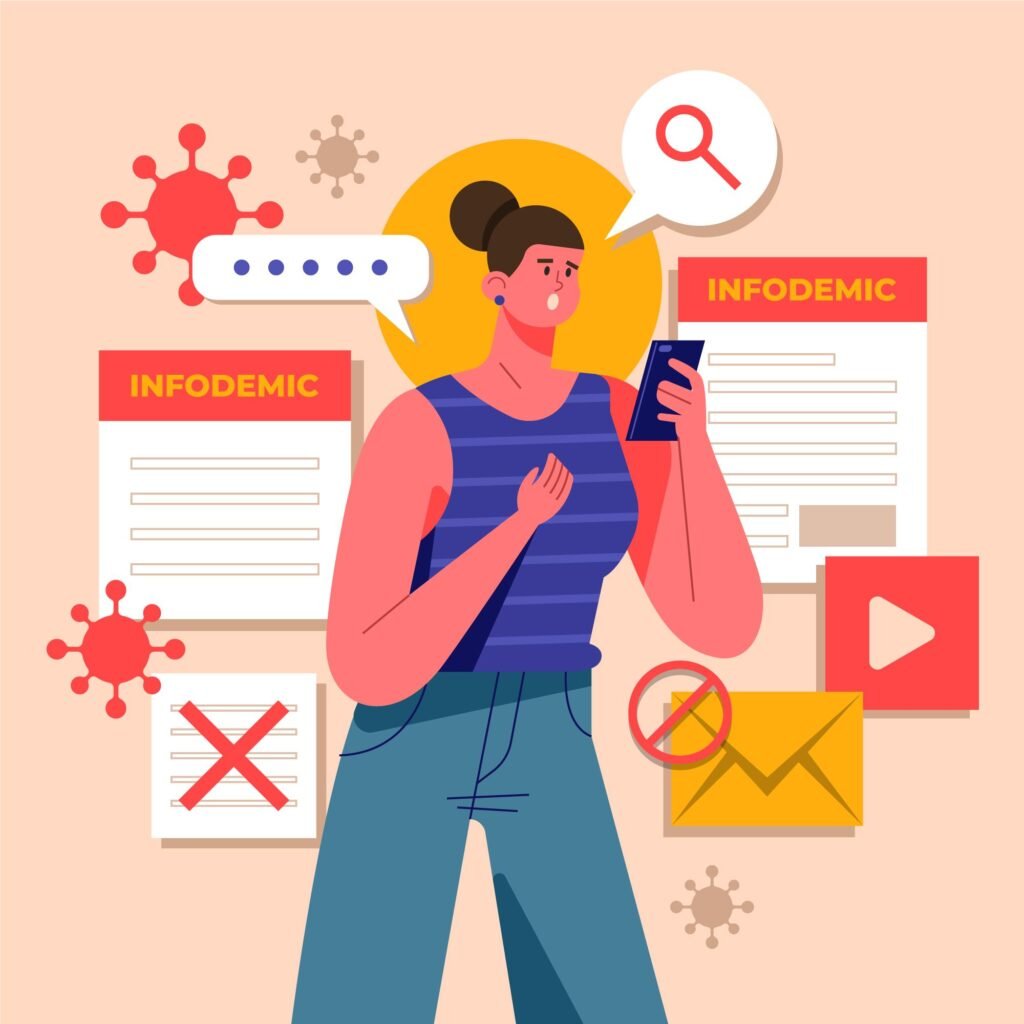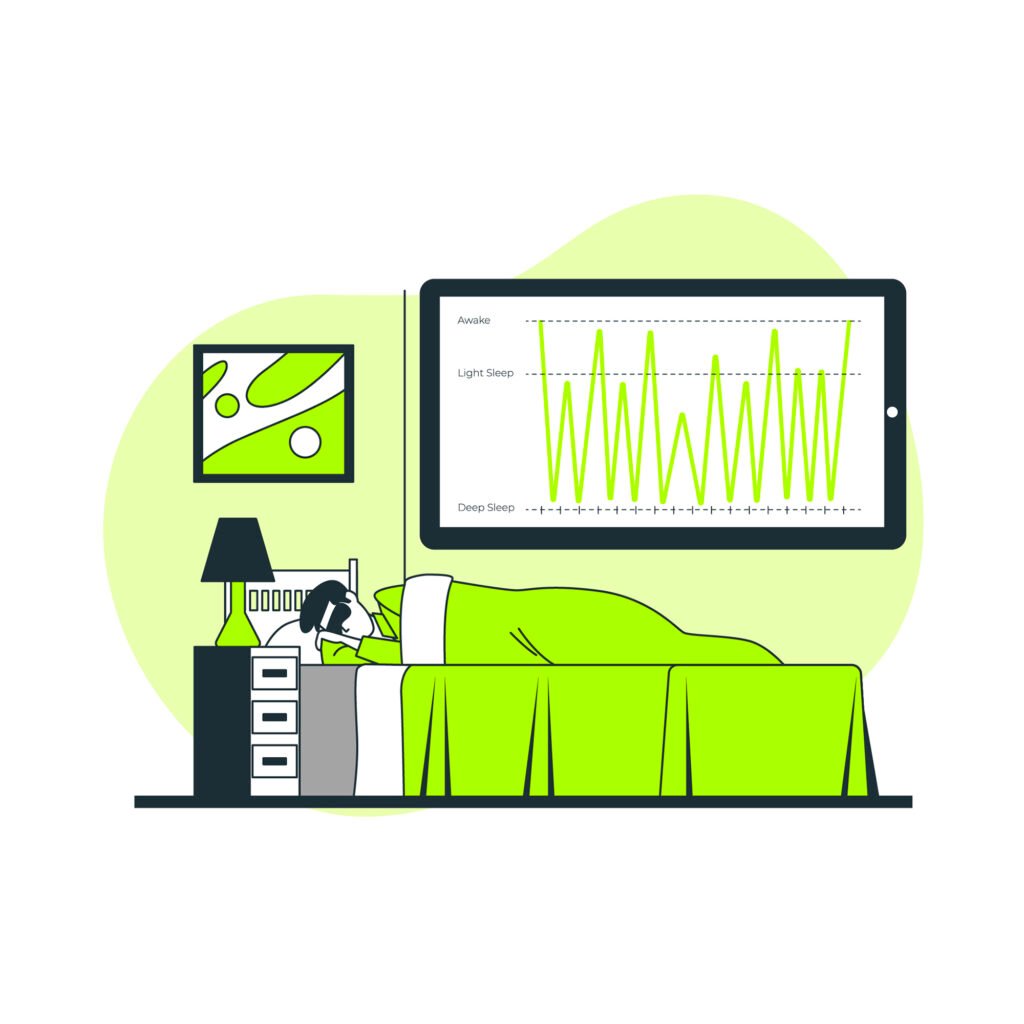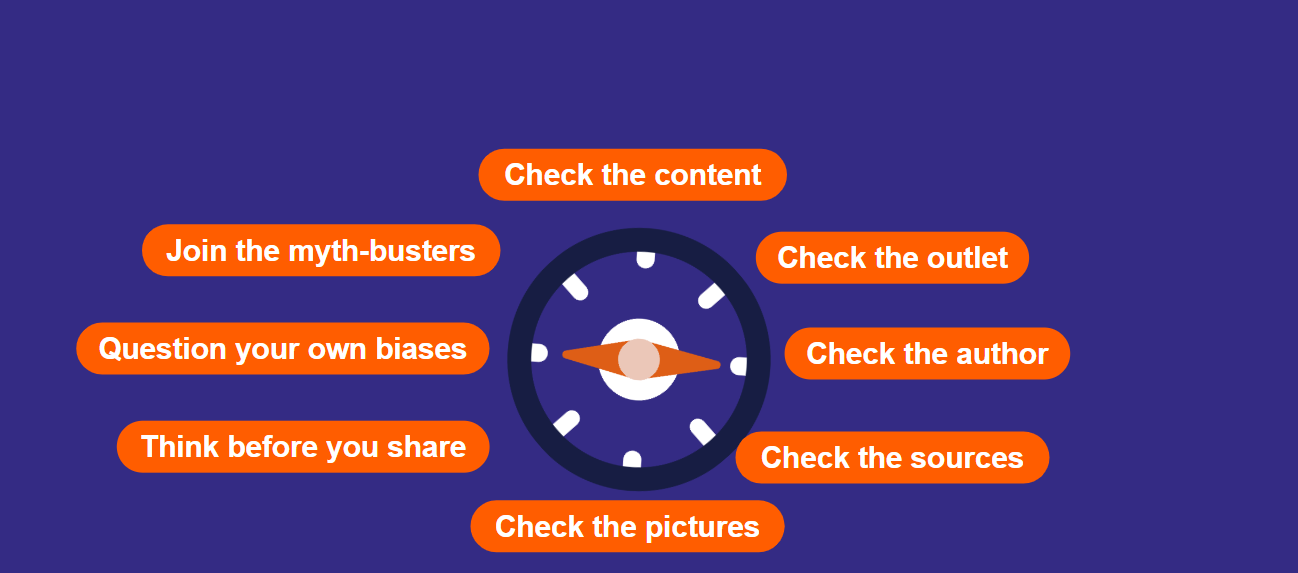LO 1 Meaning of and difference between the terms ‘information’ 'fake news' 'disinformation' 'misinformation’

Training Kits
How to adopt good reflexes to check information

Module Description
Fake news can arise from information that is completely fabricated for economic or political interests or from biased or incorrect information, written without the real intention of giving false information. Every day we are overwhelmed by an avalanche of news: some true, some false, some incorrect. Distinguishing which news is well-founded, in this sea of available information, is a skill that can be learned with practice. The module aims to examine the reflexes to be used to distinguish false information from real information and to explain what fake news and misinformation are.
Target group
Adults and youngsters in formal and non-formal training settings
Evaluation method
Reflection and
Practical activities
Materials
▶ Paper and pens, Tape, Highlighters, Markers
▶ Computer and screen for showing video examples
▶ Internet connection
Training Objectives - LOM
LO 2 Starting from information understand how to work on its deconstruction
LO 3 Understand the process of constructing the fake
LO 4 Fact-checking in the lexicon of journalism
LO 5 How to train your reflexes to detect false information
LO 6 Read, understand, verify and then share the information
LO 7 Understand the impact and damage caused by sharing false information
Concepts & Definitions
Concept 1
What is disinformation
Concept 3
How to respond to disinformation
Concept 5
Beware of manners: common mistakes when you try to explain the gravity of the fake news
Concept 2
How does disinformation works
Concept 4
Help others become aware in the face of fake news
Case study 1
Disinformation and its threats to society: Antivax Movement
THE ANTI-VAX MOVEMENT
Having a blog does not automatically turn us into scientists or doctors, far from it, gives us the responsibility of having to communicate information to our readers that is mostly verified, and that has the right references that allow us to go and check what we claim. That is if we are ethical people. Then there are those who have to bring evidence for their thesis, little does it matter whether the evidence is valid or not or if it comes from verified sources, the only thing that matters is that it carries water for theirs.
Pubmed i.e. is the digital archive of all scientific publications on a planetary level in which the studies carried out by experts are listed. It hosts all studies, those that have been verified but also those that have not been refuted. Pubmed indiscriminately collects all scientific journals, both those that publish anything, as long as you pay, and those with a very high impact factor that only publish high-level work. It is quite normal to find texts in the digital archive that say everything and the opposite of everything; what differentiates the ignorant from the scholar is precisely the ability to discern between a valid study and one that is not.
One example we can give concerns the correlation between vaccines and autism. This is one of many articles that can be found by doing a search on Pubmed. https://pubmed.ncbi.nlm.nih.gov/21623535/

Case study 2
Disinformation and its threats to society: HAARP and the conspiracy theory of chemtrails and hearthquake

HAARP (High Frequency Active Auroral Research Program)
HAARP (an acronym for High Frequency Active Auroral Research Program) is a civil and military installation located in the United States.The installation is located in Alaska, near Gakona, west of Wrangell-Santo Elias National Park, on a former United States Air Force base.
HAARP (an acronym for High Frequency Active Auroral Research Program) is a civil and military installation located in the United States.
The installation is located in Alaska, near Gakona, west of Wrangell-Santo Elias National Park, on a former United States Air Force base.
It was built in 1993, for the purpose of scientific research into the upper layers of the atmosphere and ionosphere, and radio communications for military use.
The facility has not been in operation since May 2013 for about 28 months, due to some operating cost issues, the abandonment by the military system, and the cost of retrofitting the old Diesel gensets according to the new ecological regulations.
The reopening took place on 3 September 2015, passing to the management of the University of Alaska Fairbanks and open leases and partnerships to cover the costs.
It was and still is at the centre of several conspiracy theories, e.g. the ‘fireball’ spotted in the Black Sea after the 1999 earthquake in Istanbul, when the centre was in operation.
HAARP (High Frequency Active Auroral Research Program)
The HAARP facility is capable of sending radio waves into the ionosphere. As the waves hit the ionosphere, they heat it up, causing slight disturbances, similar to those caused by solar radiation, but considerably weaker. The aim is to study how these perturbations affect short- and long-distance communications. Most of the research carried out using the facilities is in the public domain, as is the environmental impact study carried out on the facility by a number of independent bodies. A small part of the research is of military interest and the results of this research are not published. This research concerns long-distance radio communications and submarine communications, for which the use of radio waves reflected from the ionosphere seems to show considerable potential.
The basic research carried out using HAARP concerns the study of natural phenomena resulting from the interaction of solar radiation and radio waves with the ionosphere. Applied research concerns the use of the effects produced on the ionosphere in technology, particularly in the field of telecommunications.
The location of the facility is optimal because it offers a wide variety of ionospheric conditions to study[9]. The site also offers a quiet electromagnetic location as there are no surrounding noise sources such as may be produced by nearby cities or industrial settlements[9]. Monitoring is carried out by passive instrumentation on a continuous basis, and the data collected is processed and made available through diagrams on the official website[10]; high-frequency emission, on the other hand, is carried out as part of interactive study campaigns conducted by research groups.
It is used for research by both universities (public and private) in the field of telecommunications. Periodically, given the great interest generated around the facility, public access is allowed to visit the facilities. and government agencies as well as commercial companies interested in new technologies.
Some conspiracy theories, lacking objective evidence and disproved by the scientific community, describe HAARP as a project in pursuit of occult purposes, ranging from the creation of a hypothetical electromagnetic weapon to create earthquakes to climate control. Such pseudoscientific speculations are mostly related to the conspiracy theory of chemtrails, all having a common denominator in the conspiracy theories of David Icke and his supporters.
Most of these theories are in stark contrast to the laws of physics, and even in cases where there is a modicum of plausibility, the phenomena described would require powers thousands or millions of times greater than those HAARP develops (or even those it could theoretically develop). With a simple calculation, it is possible to estimate the maximum power density (the power at each individual point) of the signals emitted by the system. For example, at an altitude of 100 km (in the ionosphere) using all 180 antennas of the plant will result in an affected area of (100*100)/180=55 km² (each antenna will hit an area equal to the square of the distance, and 180 antennas will produce a beam 180 times narrower and 180 times more powerful than a single antenna). The maximum power developed by the installation is 3.6 MW (3.6 million watts), which divided by the area affected (55 km²), gives the derisory power of 0.07 watts per square metre. Furthermore, considering the gain of the antennas (31 dB), the power is further reduced to 0.03 watt per square metre, roughly equal to that of a mobile phone held one metre away. The ray, once reflected by the ionosphere, scatters over an area of tens of thousands of square kilometres, so the power density of the electromagnetic radiation reaching the ground is of the order of millionths of a watt per square metre, lower than that of any household appliance. Therefore, even if it were possible to influence the climate or geology with electromagnetic waves (and so far no mechanism has been found or hypothesised to do so), the power that can be generated by HAARP would still not be sufficient.
Let’s work on the case study!
After reading the case studies, we offer a guideline and question for self-reflections on the reported topics. When you come across a source of information, be it a book, article, website, or person, it is important to ask yourself some questions to assess its credibility and reliability.

- Were you aware of the reported cases and their media visibility?
- Why do people, instead of relying on scientific facts, prefer answers that are obviously contradictory?
- Which strategies do you think it’s better for evaluating sources?
- Who is the author or publisher?
- What are their credentials, qualifications, and affiliations?
- Are there any conflicts of interest or hidden agendas?
- What is the purpose and audience of the source?
- Is it meant to inform, persuade, entertain, or sell something?
- Is it directed at a general or specific audience?
- Is it objective or biased? When was the source published or updated?
- Is it current or outdated?
- Does it reflect the latest research and developments in the field? How is the source supported by evidence and references?
- Are there facts, data, statistics, examples, and citations?
- Are the sources of the evidence credible and reliable? Are there any gaps, errors, or inconsistencies in the information?
- How is the source relevant and useful for your topic and purpose?
- Does it address your research question or problem?
- Does it provide new insights, perspectives, or solutions?
- Does it agree or disagree with other sources?
Method 1 How to respond to disinformation
We all have a role to play in stopping disinformation from spreading, because it puts our democracies (and potentially our lives) at risk.
The group have to understand how:
1. Discuss the different steps for assessing the veracity of content, including being thoughtful before sharing and key elements in the process of fact-checking
2. Learn how to talk to others about disinformation and its dangers, and stop them perpetuating harmful and false narratives
Think Before You Share

Fact Check

Report To The Platform

Become A Personal Fact Checker For Your Family And Friends

- Being aware of disinformation and the fact that you can be a target is a first step towards protection.
- Fact-checking is a good second step and can also be fun: it’s like playing detective and the pupils could really enjoy it.
- It’s true that, most of the time, it is quite time-consuming, but we shouldn’t feel discouraged because often particular features of a piece of information already reveal a lot about the quality of the message conveyed.
- You should always look at information with a critical attitude.
– How to foster trust towards institutions and the media?
– What would happen if, in time of crisis, we did not believe what our authorities tell us to do?
What’s important is the source – it’s good to maintain a certain level of skepticism, but it’s especially -important if the source is not a reliable one.
Steps of the compass:

How you fact-check your friends and family is important! It will often determine whether they listen to you or change their minds. Below is are some ideas on how to approach these difficult conversations.
– Biggest mistake you can make:
While the temptation to insult people who believe misinformation is tempting, it is extremely counterproductive. Many of these people might have understandable, although misguided, concerns that apply to their specific situation, but not the population at large. For example, their child might have had a reaction to a vaccine because the doctors were unaware of an allergy, and they might mistrust vaccines because of it. Attacking them in such a case will only embolden their beliefs.
– Reach hard-liners by sharing their concerns:
At the end of the day people who believe misinformation (such as vaccine deniers) are people too, who just want to make sure their children are safe. The evidence however indicates that vaccines are (at the very least) safer than staying unvaccinated. Explaining this in a companionate and empathetic way is the most likely way of getting people to change their minds; in other words, be patient and be nice to them.
– The scientific process is full of uncertainty and this is not communicated very well.
Any information you provide needs to be accompanied by an honest explanation of the degree to which there is a scientific consensus or certainty. While this should not be the leading message when talking to friends and family, it should be included and accurately reflect the degree of uncertainty among experts. People need to understand that science is a process of trial error and that decisions are made based on the best information available at the time, which is subject to change as new studies are conducted.
Different platforms have different policies for dealing with disinformation, misinformation and potentially harmful content.
But you can help by proactively reporting stories and posts that seem suspicious to you (either because of their content, or because you think the account posting them might not belong to a real person, or the posting/commenting is happening in a coordinated and inauthentic manner).
The platforms usually have a function for you to easily do this.

BE ACTIVE
We ALL have a responsability to hinder the spread of misleading information
DON’T SHAME SHOW EMPATHY
Taking a tone of “you’re wrong and I’m right”does not work
How to talk about disinformation to friends and family
DON’T EXPECT IMMEDIATE CHANGE
It takes courtesy and patience to stop people spreading disinformation
Activity 1
What is disinformation
Warm-up 5 minutes
The educator introduces himself and his role and the members do the same.
The educator then introduces the task to be performed.
Exercise 20 minutes
Each component has a pen and paper. Each member must provide, without having consulted the internet or other tools, the meaning they personally attribute to the words ‘information’ ‘fake news’ ‘disinformation’ ‘misinformation’ and transcribe them on the sheet of paper. Once transcribed, the components will exchange the sheets with each other and each will read the definitions provided by their partner, making any adjustments or changes on the back of the sheet. The educator will guide the group to transcribe the actual and correct definitions of these terms.
The final aim of the exercise is to arrive at the meaning of the words clearly.
Activity 2
How disinformation works
Introduction 5 minutes
Educator guide the members of the group in understanding who are the main actors, behaviors and content that define disinformation. Those who spread information often try intentionally to evoke emotional response from readers.
Exercise 10 minutes
Starting from the example below identify examples similar to the one proposed (measles vaccination).
Analyze and discuss the motivations that can lead the process to the spread of lies.
Understand that we are all at risk from disinformation; discuss the reasons why it’s dangerous.
The members can use internet to find a similar

Activity 3
How to respond to disinformation
Watch this video.
It is using imagery out of context to construct a false narrative is this Sputnik story about children in ‘militarized’ Latvia getting indoctrinated by NATO:
Now reflect about your emotions.
What do you feel when you see this?
How would you react if this appeared in your news feed on
Instagram/Tiktok/Facebook?
Why do you feel emotional about this?
The news in itself, the way it is formulated, the picture…?
Let reflect about yourown bias. Do you feel this news confirms what you already believe? Would it have made a difference if this news was shared by a friend you like/ celebrities you follow…?
Discuss how you can check if this is true (the steps of the compass slide): check the content/ outlet/ author/ sources/ pictures/ myth busters. Let reflect on what is a trusted source and what not.
THINK BEFORE YOU SHARE!!
Show video of EUvsDisinfo as inspiration:
https://www.facebook.com/EUvsDisinfo/videos/2584252091848910/
How can I verify the reliability of a website?
URL analysis: always check if it is the original website or if the URL is built with a slight modification in the name or extension, with the idea that a distracted or hasty reader would not notice. Disinformation sites take the names of well-known news sources, changing small details. For example: (from the slide at the beginning) dailypresser.com, or nevvyorktimes.com.
Check the date and author:
Public figures on social media often (but not always) have their accounts “verified”, as well as media and journalists. Often people working in the information industry have websites or other public profiles that can help you find them and their work.
Search for the story on the internet
Do other sources support what is claimed? Do you know what kind of sources they are?
Check if pictures look strange or doctored.
If so, you can do a reverse search on Google images:
https://support.google.com/websearch/answer/1325808?co=GENIE.Platform%3DAndroid&hl=en.
You might find out that it’s from a different event or an earlier date.
Think about the context around the information:
Imagine that a phone manufacturer tells you that sales have doubled.
Now add context: It was December, holiday season, a lot of discounts are going on in stores and buying a phone is simply a little cheaper. This was to be expected, right? The same happens often also in public debates about political issues.
Tips for trainers
1) make sure you have adequately prepared the place where the trainees will be training: a classroom or a space where they can all work together but also in separate groups;
2) check that all the necessary tools are in place: pc, tablet, internet connection, wi-fi, notebooks, pens, markers and various stationery, whiteboard with sheets;
3) do not underestimate the warm-up phase: getting to know the group facilitates group work;
4) remember to provide for breaks and debreafing moments.
Quizzes
- When we try to make friends and family realise that a piece of news is false, we have to blame them for sharing it.
- If I don’t know if a piece of news is true, I share it anyway in case it might be useful to someone.
- The spread of fake news is also about the personal emotional component.
